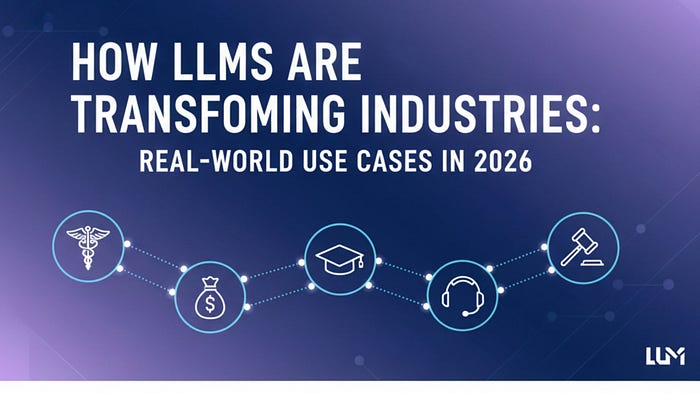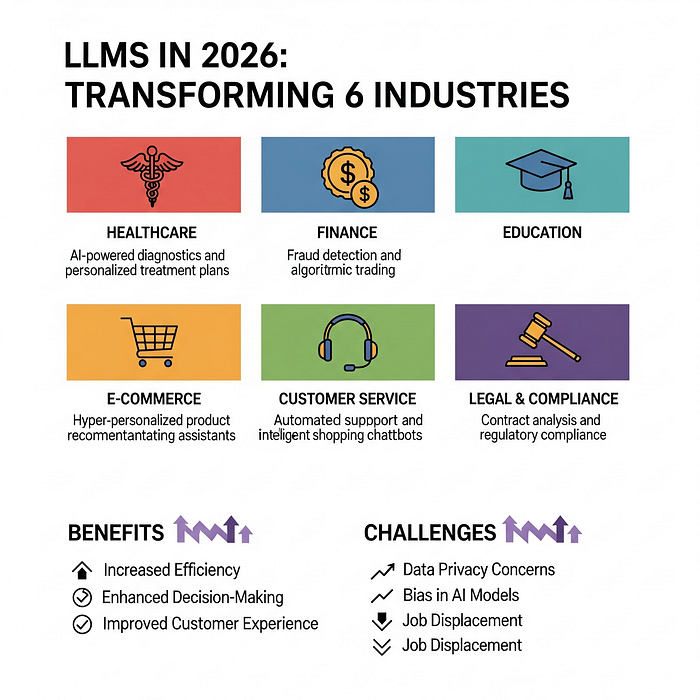How LLMs Are Transforming Industries: Real-World Use Cases in 2026

AI is No Longer the Future — It’s Now
2026 has become the year where AI stopped being a buzzword and started becoming an operational reality across industries. From automating healthcare diagnoses to enabling personalized education, Large Language Models (LLMs) are at the heart of this revolution.
Hey, I’m Nate Patel — an AI strategist and tech enthusiast exploring the incredible impact of AI on the world as we know it. I’ve been writing and consulting in the AI space for years, and what we’re witnessing today with LLMs is unlike anything before. In this article, I’ll break down how LLMs are transforming industries with real-world applications that are not just experimental — but already in motion.
So, let’s uncover how LLMs are stepping beyond text generation and emerging as a force multiplier across sectors.
What Are LLMs? Understanding the Backbone of Modern AI
Large Language Models (LLMs) are a subset of AI trained on vast amounts of text data to understand, interpret, and generate human-like language. In 2026, their capabilities have evolved far beyond simple chat interactions. They now support reasoning, decision-making, summarization, coding, data interpretation, and even autonomous workflows.
These models have become central to digital transformation strategies, especially for organizations looking to enhance productivity, reduce costs, and unlock new value streams.
The Evolution of LLMs by 2026
From GPT-1’s 117M parameters to GPT-5 and beyond, the trajectory of LLMs has been exponential. Today’s models integrate multimodal inputs (text, images, speech), reasoning abilities, and domain-specific fine-tuning — all making them intelligent, adaptable, and industry-ready.
The introduction of AI-native platforms and decentralized LLMs has also democratized access, allowing startups and enterprises alike to reap the benefits of generative AI without incurring massive infrastructure costs.
Top Industries Transformed by LLMs (with Real Use Cases)

1. Healthcare: Personalized, Efficient & Data-Driven
LLMs are unlocking precision healthcare like never before.
- Diagnosis Support: Doctors now use LLM-powered assistants to analyze patient history, medical literature, and symptoms in real-time.
- Patient Engagement: Automated agents provide empathetic consultation and follow-ups.
- Research Acceleration: Faster literature reviews and drug discovery insights using generative reasoning.
Real-world example:
Leading hospitals are integrating LLMs to reduce administrative burdens and improve diagnostic accuracy, cutting costs by nearly 30% and slashing time-to-treatment.
2. Finance: Smarter Decisions, Fewer Risks
In 2026, LLMs are empowering finance professionals to predict trends, manage risks, and personalize banking.
- Fraud Detection: LLMs analyze behavioral patterns and detect anomalies in real-time.
- Personal Finance Assistants: Conversational AI now provides personalized recommendations that align with user financial goals.
- Regulatory Compliance: LLMs streamline reporting and ensure compliance with ever-changing regulations.
Real-world example:
Fintech companies are using LLMs to automate end-to-end lending decisions, reducing default risks and approving loans in under 5 minutes.
3. Education: From One-Size-Fits-All to Tailored Learning
Education is undergoing a transformation powered by AI-fueled personalization.
- Adaptive Learning: LLMs customize learning materials based on skill level, behavior, and progress.
- Automated Grading: Teachers save time with AI grading summaries, feedback, and rubric-based assessments.
- Tutoring Agents: Students have 24/7 access to AI tutors capable of explaining concepts in any language or style.
Real-world example:
EdTech platforms use LLMs to create smart academic content and assessments tailored to individual student needs, boosting retention and performance.
Read More: How LLMs Are Transforming Industries: Real-World Use Cases in 2026



Comments
Post a Comment